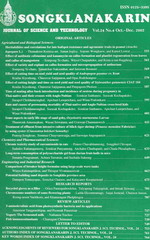ThaiScience
ThaiScience
SONGKLANAKARIN JOURNAL OF SCIENCE & TECHNOLOGY
Volume 42, No. 02, Month MARCH, Year 2020, Pages 292 - 298
Self potential and 2 d resistivity application for groundwater exploration in fractured reservoirs
Muhammad Taqiuddin Zakaria, Nordiana Mohd Muztaza, Adeeko Tajudeen Olugbenga, Rosli Saad, Muhammad Nazrin A Rahman
Abstract Download PDF
The high demand for various uses of water related to domestic and industrial requirements is increasing rapidly. Alternative water supplies with less pollution and more economic value are needed to support the demand. The self-potential and 2-D resistivity methods were used to identify the flow pathways of the water and potential groundwater zones in Johor, Malaysia by measurement of the potential difference between two non-polarizable copper electrodes and resistivity distribution of the subsurface. The recharge zone of the aquifer was identified with negative potential values (0 to 140 mV) while positive values (0 to 140 mV) showed the discharges zones for this area. The self-potential results showed the flow pathways of groundwater in the direction of southeast to northwest of the study area. A potential groundwater zone was identified at resistivity values of <100 Ωm at depths >50 m. The high contrast of resistivity values indicated a fracture/fault for this area.
Keywords
self-potential, 2-D resistivity, surface water, groundwaterSONGKLANAKARIN JOURNAL OF SCIENCE & TECHNOLOGY
Published by : Prince of Songkla University
Contributions welcome at : http://rdo.psu.ac.th
